Cutting (plant)
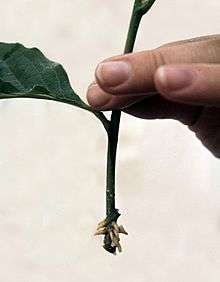
A plant cutting is a piece of a plant that is used in horticulture for vegetative (asexual) propagation. A piece of the stem or root of the source plant is placed in a suitable medium such as moist soil. If the conditions are suitable, the plant piece will begin to grow as a new plant independent of the parent, a process known as striking. A stem cutting produces new roots, and a root cutting produces new stems. Some plants can be grown from leaf pieces, called leaf cuttings, which produce both stems and roots. The scions used in grafting are also called cuttings.[1]
Propagating plants from cuttings is an ancient form of cloning.[2][3] There are several advantages of cuttings, mainly that the produced offspring are practically clones of their parent plants. If a plant has favorable traits, it can continue to pass down its advantageous genetic information to its offspring. This is especially economically advantageous as it allows commercial growers to clone a certain plant to ensure consistency throughout their crops.[4]
The poet Theodore Roethke wrote about plant cuttings and root growth behavior in his poems "Cuttings" and "Cuttings (Later)" found in his book The Lost Son: And Other Poems.[5]
Evolutionary advantage: Succulents
Cuttings are used as a method of asexual reproduction in succulent horticulture, commonly referred to as vegetative reproduction. A cutting can also be referred to as a propagule. Succulents have evolved with the ability to use adventitious root formation in reproduction to increase fitness in stressful environments. Succulents grow in shallow soils, rocky soils, and desert soils.[6] Seedlings from sexual reproduction have a low survival rate; however, plantlets from the excised stem cuttings and leaf cuttings, broken off in the natural environment, are more successful.[6] Cuttings have both water and carbon stored and available, which are resources needed for plant establishment. The detached part of the plant remains physiologically active, allowing mitotic activity and new root structures to form for water and nutrient uptake.[6] Asexual reproduction of plants is also evolutionarily advantageous as it allows plantlets to be better suited to their environment though retention of epigenetic memory, heritable patterns of phenotypic differences that are not due to changes in DNA but rather histone modification and DNA methylation.[7] Epigenetic memory is heritable through mitosis, and thus advantageous stress response priming is retained in plantlets from excised stem.[7]
Physiology
Adventitious root formation refers to roots that form from any structure of a plant that is not a root; these roots can form as part of normal development or due to a stress response.[8] Adventitious root formation from the excised stem cutting is a wound response.
At a molecular level when a cutting is first excised at the stem there is an immediate increase in jasmonic acid, known to be necessary for adventitious root formation.[9] When the cutting is excised from the original root system the root inhibiting hormones, cytokinin and strigolactone, which are made in the root and transported to the stem, decrease in concentration.[8] Polyphenol degradation decreases, increasing auxin concentration. The increased auxin concentration increases nitric oxide concentration which initiates root formation through a MAPK signal cascade and a cGMP-dependent pathway that that both regulate mitotic division and are both necessary for the initiation of adventitious root formation.[10] The root primordia form from cambial cells in the stem.[8] In propagation of detached succulent leaves and leaf cuttings, the root primordia typically emerges from the basal callous tissue after the leaf primordia emerges.[11]
It was known as early as 1935 that when indolyl-3-acetic acid (IAA), also known as auxin, is applied to the stem of root cuttings, there is an increase the average number of adventitious roots compared to cuttings that are not treated. Researchers also applied this compound to stems without leaves that normally would not have any root formation and found that auxin induced root formation, thus determining auxin is necessary for root formation.[12] Identification of this hormone has been important to industries that rely on vegetative propagation,[8] as it is sometimes applied to fresh cuttings to stimulate root growth.
Technique

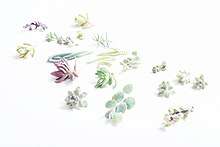
Some plants form roots much more easily than others. Stem cuttings from woody plants are treated differently, depending on the maturity of the wood:
- Softwood cuttings come from stems that are rapidly expanding, with young leaves. In many species, such cuttings form roots relatively easily.[13][14]
- Semi-hardwood cuttings come from stems that have completed elongation growth and have mature leaves.
- Hardwood cuttings come from fully matured stems, and are often propagated while dormant.
Most plant cuttings are stem pieces, and have no root system of their own, they are likely to die from dehydration if the proper conditions are not met. They require a moist medium, which, however, cannot be too wet lest the cutting rot. A number of media are used in this process, including but not limited to soil, perlite, vermiculite, coir, rock wool, expanded clay pellets, and even water given the right conditions. Most succulent cuttings can be left in open air until the cut surface dries, which may improve root formation when the cutting is later planted.
In temperate countries, stem cuttings may be taken of soft (green or semi-ripe) wood and hard wood which has specific differences in practice. Certain conditions lead to more favorable outcomes for cuttings; timing, size, location on the plant, and amount of foliage are all important. Stem cuttings of young wood should be taken in spring from the upper branches, while cuttings of hardened wood should be taken in winter from the lower branches. Common bounds on the length of stem cuttings are between 5–15 centimetres (2.0–5.9 in) for soft wood and between 20–25 centimetres (7.9–9.8 in) for hard wood. Soft wood cuttings do best when about two thirds of the foliage removed,[15] while hard wood stem cuttings need complete foliage removal.
The environment for cuttings is generally kept humid—often attained by placing the cuttings under a plastic sheet or in another confined space where the air can be kept moist—and partial shade to prevent the cutting from drying out. Cuttings in the medium are typically watered with a fine mist to avoid disturbing plants. Following the initial watering, the aim to keep the soil moist but not wet and waterlogged; the medium is allowed to almost dry out before misting again.[15]
A rooting hormone may be administered to "encourage" growth and can increase the success rate of plant growth.[16] Though not essential, several compounds may be used to promote the formation of roots through the signaling activity of plant hormone auxins. Among the commonly used chemicals is indole-3-butyric acid (IBA) used as a powder, liquid solution or gel. This compound is applied either to the cut tip of the cutting or as a foliar spray. Rooting hormone can be manufactured naturally, such as soaking the yellow-tipped shoots of a weeping willow tree in water or to preparing a tea from the bark of a willow tree. Shoots or bark do better when soaked for 24 hours prior to using.[17] The extract obtained from the crushing of leaves and bulbs of coco-grass (Cyperus rotundus) is used as an excellent rooting of cuttings and seedlings of various plant species.[18][19] Honey, though it does not contain any plant hormones, can also aid in rooting success through its natural antiseptic and antifungal properties.[20][21] Cinnamon or an Aspirin tablet in water[22], can also aid the rooting process.[23]
Types
Many vegetative parts of a plant can be used. The most common methods are:
- Stem cuttings, in which a piece of stem is part buried in the soil, including at least one leaf node. The cutting is able to produce new roots, usually at the node.
- Root cuttings, in which a section of root is buried just below the soil surface, and produces new shoots.[25]
- Scion cuttings are used in grafting.
- Leaf cuttings, in which a leaf is placed on moist soil. These have to develop both new stems and new roots. Some leaves will produce one plant at the base of the leaf. In some species, multiple new plants can be produced at many places on one leaf, and these can be induced by cutting the leaf veins. The leaf cutting method is commonly used with succulents.
Although some species, such as willow, blackberry and pelargoniums can be grown simply by placing a cutting into moist ground, the majority of species require more attention. Most species require humid, warm, partially shaded conditions to strike, thus requiring the approach above to be followed. Particularly difficult species may need cool air above and warm soil. In addition, with many more difficult cuttings, one should use the type of cutting that has the most chance of success with that particular plant species.[26]
Improving results

There are ways of improving the growth of stem cutting propagations. Intensifying light allows cuttings to root and sprout faster, though the heat thus generated could cause the propagation material distress.[27] Azalea cuttings can be mildly heated in water to disinfect it from the fungus pathogen Rhizoctonia, and this could potentially be used for other plants.[28]
Providing the right soil
Depending on the type of soil being used, several additives may need adding to create good soil for cuttings. These additions may include:
- chalk; to increase the pH-value of the soil; a pH of 6-6.5 is to be maintained
- organic substance/humus; to increase nutrient load; keep to a bare minimum though
- sand or gravel; to increase the soil's water permeability
For example, with plain potting soil, a third of the container should be filled with sand, to make suitable soil for cuttings.
Providing the right humidity
Although several options can be used here, usually semi-white plastic is used to cover the cuttings. The soil below and from the cuttings themselves is kept moist, and should be aerated once in a while to prevent formation of molds. A plastic bottle can be used as a small greenhouse to provide the right humidity level.
Plant propagation by cutting
Plants which can be propagated from stem, leaf and/or tip cuttings include:[29]


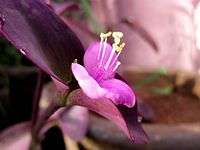

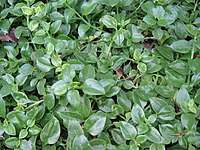
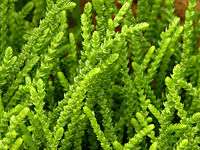
- African Violet – tip or leaf cutting
- Aglaonema – tip cuttings
- Azalea – stem cuttings
- Aptenia – stem cuttings
- Baby's tears – stem cuttings
- Begonia – tip, leaf and stem cuttings
- Blackberries (Rubus occidentalis) – stem cuttings
- Brassaia actinophylla – tip cuttings
- Bryophyllum – leaf or cuttings
- Cactus – leaf cuttings
- Cabbage palm – stem and tip cuttings
- Cannabis – stem cuttings
- Christmas cactus – tip cuttings
- Citrus – tip cuttings
- Coleus – tip cuttings
- Common purslane – stem cuttings
- Croton – tip cuttings
- Cordyline terminalis – tip cuttings
- Crassula – stem or leaf cuttings
- Dieffenbachia – tip cuttings
- Echeveria – leaf cuttings
- Ficus elastica – tip cuttings
- Ficus benjamina – tip cuttings
- Fittonia – tip cuttings
- Geranium – tip cuttings
- Golden pothos – tip or stem cuttings
- Grapes – stem cuttings, grafting, aerial layering
- Grape ivy – tip cuttings or stem cuttings
- Hedera – stem cuttings
- Hoya carnosa – tip cuttings
- Hops – stem cuttings
- Impatiens – tip cuttings
- Jade plant – tip or leaf cuttings
- Jasmine – stem cutting
- Kalanchoe – leaf or stem cuttings
- Kumquat – stem cutting
- Lemon balm – stem cuttings
- Maranta – tip cuttings
- Marjoram – stem cuttings
- Manioc (cassava) – stem cuttings
- Monstera – tip cuttings
- Mint – stem cuttings
- Oregano – stem cuttings
- Parsley – stem cuttings
- Pelargonium – tip cuttings
- Peperomia – tip or leaf cuttings
- Philodendron – tip and stem cuttings
- Pilea cadierei – tip cuttings
- Pineapple – stem cuttings
- Podocarpus – tip cuttings
- Poinsettia – stem cuttings
- Plum – stem cuttings
- Poplar – stem cuttings
- Red-hot cat tail – stem cuttings
- Resurrection plant – tip cuttings
- Rosemary – stem cuttings
- Sage – stem cuttings
- Sansevieria – leaf cuttings
- Sedum – leaf cuttings
- Sugar cane – stem cuttings
- Syngonium – stem cuttings
- Tea – stem cuttings
- Shrimp plant – tip cuttings
- Swedish ivy – tip, leaf or stem cuttings
- Thyme – stem cuttings
- Tradescantia pallida – stem cuttings
- Tradescantia zebrina – stem cuttings
- Vanilla – stem cuttings
- Verbena – stem cuttings
- Willow – stem cutting
To note, some plants listed above may require water for them to root, before they can be transplanted to soil.[30]
See also
References
- ↑ Propagation by Cuttings, Layering and Division Diane Relf, Extension Specialist, Environmental Horticulture; and Elizabeth Ball, Program Support Technician; Virginia Tech
- ↑ McKey, Doyle; Elias, Marianne; Pujol, Benoît; Duputié, Anne (2010-04-01). "The evolutionary ecology of clonally propagated domesticated plants". New Phytologist. 186 (2). doi:10.1111/j.1469-8137.2010.03210.x#pane-pcw-references. ISSN 1469-8137.
- ↑ Reproduction and cloning BBC © 2014
- ↑ Hussey, G. (1978). "The application of tissue culture to the vegetative propagation of plants". Science Progress (1933- ). 65 (258): 185–208. JSTOR 43420451.
- ↑ Roethke, Theodore (1948). The Lost Son: And Other Poems.
- 1 2 3 Gravatt (December 2004). "Description of Asexual Reproduction in a Texas succulent Sedum Wright 2 (Crassulaceae)" (PDF). SIDA, Contributions to Botany. 21 (2): 943–950.
- 1 2 Crisp, Peter A.; Ganguly, Diep; Eichten, Steven R.; Borevitz, Justin O.; Pogson, Barry J. (2016-02-01). "Reconsidering plant memory: Intersections between stress recovery, RNA turnover, and epigenetics". Science Advances. 2 (2): e1501340. doi:10.1126/sciadv.1501340. ISSN 2375-2548.
- 1 2 3 4 Steffens, Bianka; Rasmussen, Amanda (2016-02-01). "The Physiology of Adventitious Roots". Plant Physiology. 170 (2): 603–617. doi:10.1104/pp.15.01360. ISSN 0032-0889. PMC 4734560. PMID 26697895.
- ↑ Rasmussen; Hossseini; Hajirezaei; Druege; Geelen (2015). "Adventitious rooting declines with the vegetative to reproductive switch and involves a changed auxin homeostasis" (PDF). Journal of Experimental Botany. 66 (5): 1437–1452.
- ↑ Pagnussat, Gabriela Carolina; Lanteri, María Luciana; Lombardo, María Cristina; Lamattina, Lorenzo (May 2004). "Nitric oxide mediates the indole acetic acid induction activation of a mitogen-activated protein kinase cascade involved in adventitious root development". Plant Physiology. 135 (1): 279–286. doi:10.1104/pp.103.038554. ISSN 0032-0889. PMC 429373. PMID 15122018.
- ↑ Gravatt (December 2004). "Description of Asexual Reproduction in a Texas succulent Sedum Wright 2 (Crassulaceae)" (PDF). SIDA, Contributions to Botany. 21 (2): 943–950.
- ↑ Cooper, William C. (October 1935). "Hormones in relation to root formation of stem cuttings". Plant Physiology. 10 (4): 789–794. ISSN 0032-0889. PMC 439200. PMID 16653316.
- ↑ "Cuttings: softwood". rhs.org.uk. Retrieved 1 October 2017.
- ↑ "How to take softwood cuttings". gardenersworld.com. Retrieved 1 October 2017.
- 1 2 Buchan, Ursula (3 April 2010). "How to take plant cuttings". The Telegraph. Retrieved 3 October 2017.
- ↑ "How to grow plants using cuttings". readersdigest.co.uk. Retrieved 2 October 2017.
- ↑ "How to make your own rooting hormone". Pioneerthinking.com. 2005-11-02. Archived from the original on 2010-02-26. Retrieved 2010-02-21.
- ↑ YAMASHITA, Oscar Mitsuo et al. SEEDLING PRODUCTION OF FRUIT AND ORNAMENTAL SPECIES TO THE USE OF WEED HORMONE (Cyperus rotundus). Nucleus, Ituverava, v. 14, n. 1, p. 279-288, apr. 2017. ISSN 1982-2278. Disponível em: <http://nucleus.feituverava.com.br/index.php/nucleus/article/view/1988>. Acesso em: 25 june 2018. doi:https://dx.doi.org/10.3738/1982.2278.1988
- ↑ Rezende, F.P.F; Zuffellato-Ribas, K.C; Koehler, H.S (2013). "Aplicação de extratos de folhas e tubérbulos de Cyperus rotundus L. E de auxinas sintéticas na estaquia caulinar de Duranta repens L". Revista Brasileira de Plantas Medicinais. 15 (4 suppl 1): 639. doi:10.1590/S1516-05722013000500003
- ↑ Oliver, R. W. "Honey as a stimulant to the rooting of cuttings." Scientific Agriculture 19.9 (1939): 586-588.
- ↑ Tilley, Nikki. "Honey As A Root Hormone: How To Root Cuttings With Honey". gardeningknowhow.com. Retrieved 2 October 2017.
- ↑ Larqué-Saavedra, Alfonso, and Rodolfo Martin-Mex. "Effects of salicylic acid on the bioproductivity of plants." Salicylic acid: A Plant Hormone. Springer, Dordrecht, 2007. 15-23.
- ↑ Wong, James (31 January 2016). "Gardens: drug therapy for plants". The Guardian. Retrieved 2 October 2017.
- ↑ "HO-37: New Plants from Cuttings". purdue.edu.
- ↑ Carroll, Jackie. "What Are Root Cuttings: Information On Taking Cuttings From Root Growth". gardeningknowhow.com. Retrieved 2 October 2017.
- ↑ "Certain plant species having more success with certain types of cuttings". Healthrecipes.com. Retrieved 2010-02-21.
- ↑ Wallheimer, Brian (January 23, 2012). "Study shines light on ways to cut costs for greenhouse growers". Lopez and Currey. Purdue University. Retrieved July 31, 2012.
- ↑ Yao, Stephanie (December 24, 2009). "Hot Water Treatment Eliminates Rhizoctonia from Azalea Cuttings". USDA Agricultural Research Service. Physorg. Retrieved July 31, 2012.
- ↑ Propagating Foliage & Flowering Plants
- ↑ Grow an Endless Supply of Herbs from Cuttings by Emily Han
| Wikimedia Commons has media related to Cuttings. |
External links
| Wikiversity has learning resources about Plant propagation |
